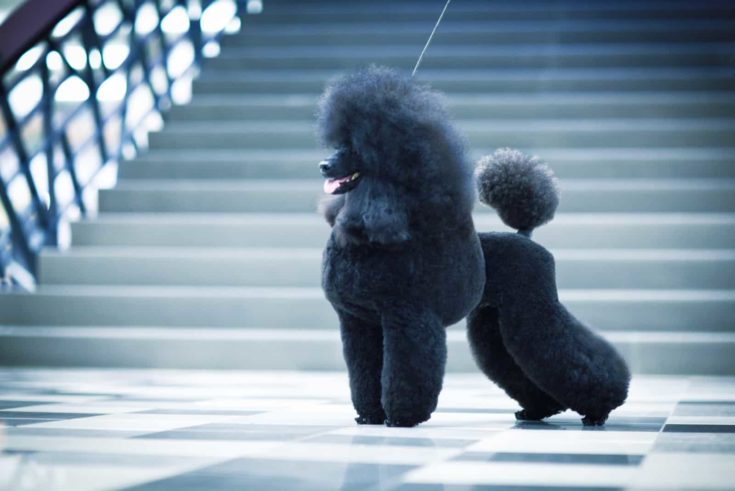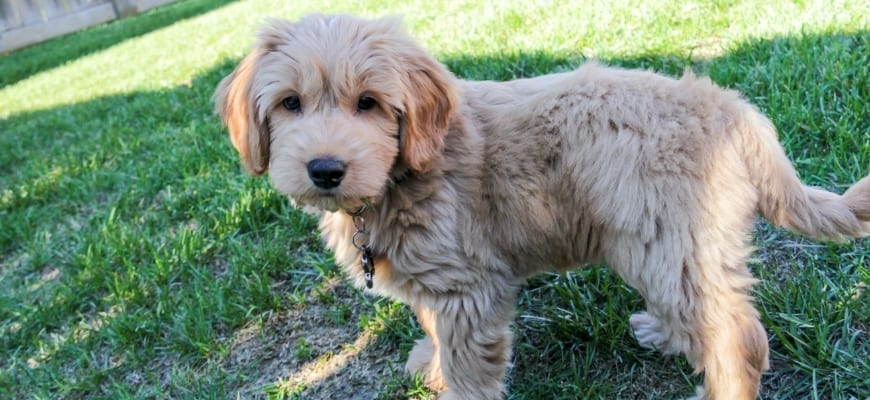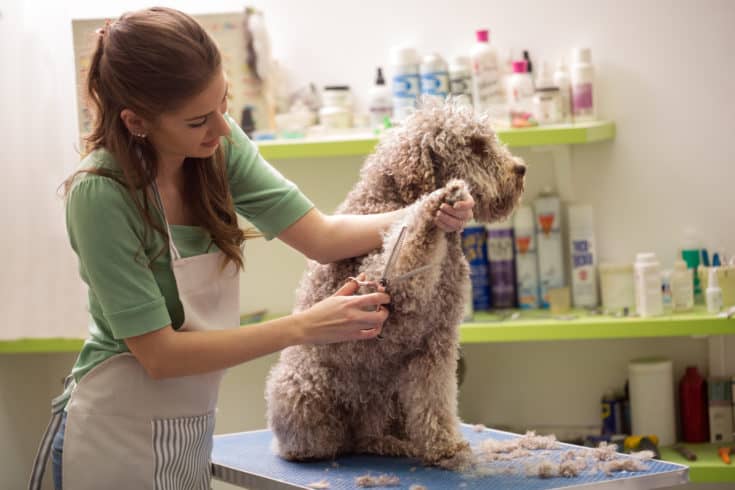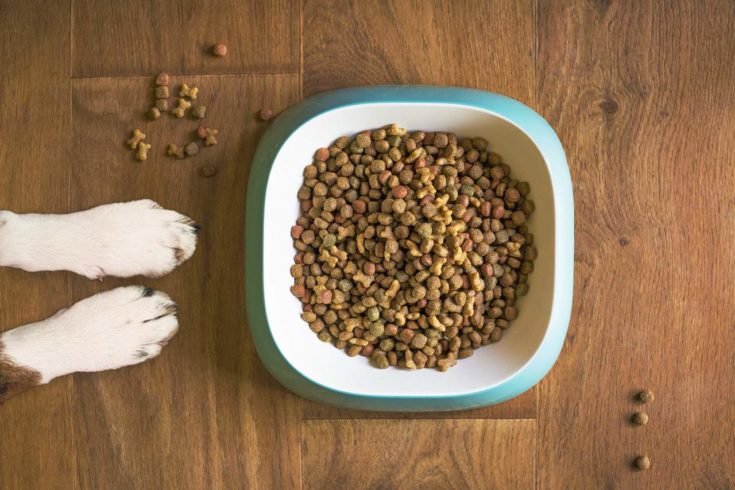Teddy Bear Goldendoodle vs. Goldendoodle – are these dogs the same breed or completely different? Which is easier to train? And are Goldendoodle puppies more expensive to buy than Teddy Bear Goldendoodles?
Before you begin your search for the ideal canine companion, you’ll need to know the similarities and differences between these two popular breeds.
Keep reading to learn everything you need to know about the Teddy Bear Goldendoodle vs. the Goldendoodle.
Table of Contents
Teddy Bear Goldendoodle vs. Goldendoodle – What’s The Difference?

The Goldendoodle is a crossbreed dog that’s produced by crossing a purebred Poodle with a purebred Golden retriever. A Teddy Bear Goldendoodle is also sometimes referred to as the English Goldendoodle and this breed is created by crossing a purebred Poodle with an English Cream Golden Retriever.
Both Doodles can be different sizes, depending on the Poodle parent, which can be a Toy, Miniature, or Standard variety. Both the parent dogs should be registered as being purebred with the American Kennel Club (AKC).
The puppies produced are referred to as F1 hybrid Doodles.
Teddy Bear Goldendoodle vs. Goldendoodle – Parent Breeds Compared
As you can see, both these Goldendoodles have a Poodle parent. So, the key differences between these two distinct breeds are down to the Golden retriever parentage.
English Cream Golden Retriever vs. American and Canadian Golden Retriever
First of all, it’s important to note that the English Cream Golden retriever is not recognized by the AKC as a breed in its own right. However, the Canadian and UK Kennel Clubs both do acknowledge the breed as being distinct from the other retriever types.
So, there are three kinds of Golden retriever:
- American
- English
- Canadian
All these variants are descended from the original Scottish line of dogs.
Golden retrievers are thought to have originally been bred as tracker dogs in Russia. However, in the mid-1800s, the modern retriever breed was created in Scotland by Baron Tweedmouth of the Dudley Marjoribanks estate. The dogs were used for duck hunting, retrieving shot birds from marshes and bodies of water. So, retrievers have a flat, double coat that keeps them warm and dry in the coldest of conditions, and they have plenty of stamina to enable them to spend all day traversing rugged mountain terrain.
Goldens found their way across the Pond to the US and Canada, where slightly different breeding processes have caused a few variations in the breeds.
Subtle Differences
The English Cream Golden retriever is much lighter in color than its US and Canadian cousins, ranging from pale cream to light yellow. In contrast, American Goldens range from light golden to deep, vibrant auburn.
Generally, English Cream Golden retrievers are slightly smaller and have some facial differences, including rounder eyes and a broader head. Also, these dogs have a straighter topline from the base of the neck to the top of the tail, and they are stockier in build.
The Poodle

Poodles originate from Germany or France and were originally bred as a working breed, accompanying duck hunters in the field as bird dogs. Today, most Poodles are kept as family pets.
Poodles come in three sizes, toy, miniature, and standard. It’s the puppy’s Poodle ancestry that determines the size of the Goldendoodle puppies that are produced.
Comparison of Teddy Bear Goldendoodles and Goldendoodles
Here’s an at-a-glance overview of these two beautiful Goldendoodles:
Summary Table
Features
Teddy Bear Goldendoodle
Goldendoodle


Height:
17 to 24 inches
20 to 24 inches
Weight:
40 to 90 pounds
50 to 90 pounds
Coat:
Can be curly, straight or wavy
Can be curly, straight or wavy
Color:
Golden, cream
Red, cream, apricot, black, chocolate
Lifespan:
10 to 15 years
10 to 15 years
Health:
Patellar Luxation, Hip Dysplasia, Cataracts, PRA, Skin conditions, Epilepsy, Cancer
Patellar Luxation, Hip Dysplasia, Cataracts, PRA, Skin conditions, Epilepsy, Cancer
Intelligence:
High
High
Temperament:
Friendly, loyal, sociable, and eager to please
Friendly, loyal, sociable, and eager to please
Diet:
Depends on the size of the dog
Depends on the size of the dog
Exercise requirements:
Needs one hour of daily outdoor exercise, training, games, etc
Needs one hour of daily outdoor exercise, training, games, etc
Prize
Around $3,500
From $2,000
Teddy Bear Goldendoodle

Height:
17 to 24 inches
Weight:
40 to 90 pounds
Coat:
Can be curly, straight or wavy
Color:
Golden, cream
Lifespan:
10 to 15 years
Health:
Patellar Luxation, Hip Dysplasia, Cataracts, PRA, Skin conditions, Epilepsy, Cancer
Intelligence:
High
Temperament:
Friendly, loyal, sociable, and eager to please
Diet:
Depends on the size of the dog
Exercise requirements:
Needs one hour of daily outdoor exercise, training, games, etc
Price:
Around $3,500
Goldendoodle

Height:
20 to 24 inches
Weight:
50 to 90 pounds
Coat:
Can be curly, straight or wavy
Color:
Red, cream, apricot, black, chocolate
Lifespan:
10 to 15 years
Health:
Patellar Luxation, Hip Dysplasia, Cataracts, PRA, Skin conditions, Epilepsy, Cancer
Intelligence:
High
Temperament:
Friendly, loyal, sociable, and eager to please
Diet:
Depends on the size of the dog
Exercise requirements:
Needs one hour of daily outdoor exercise, training, games, etc
Price:
From $2,000
Teddy Bear Goldendoodle vs. Goldendoodle Direct Comparison
Now, let’s compare these two breeds side-by-side.
Size and Average Weight
Although the Teddy Bear Goldendoodle is the slightly smaller one of these two breeds, they both fall into the same basic Goldendoodle categories when it comes to size.
Miniature

Miniature Goldendoodles are created by crossbreeding a Golden Retriever with a Toy or Miniature Poodle.
These dogs typically weigh between 15 and 35 pounds, standing from 13 inches to 20 inches tall from paw to shoulder.
Medium
Medium Goldendoodles stand from between 17 inches and 20 inches at the shoulder, weighing in at between 40 pounds and 50 pounds.
Standard

Standard is the largest size of Goldendoodle. These dogs can stand from 20 inches to 24 inches tall at the shoulder and weigh between 50 pounds and 90 pounds at maturity.
Coat Type And Shedding
Golden retrievers of all types are reputed to shed massively! In fact, the main reason for crossing this breed with a Poodle is to dramatically reduce shedding, making the dogs more suitable for life in a home with allergy sufferers.
Depending on the generation of Doodle you choose, your puppy might have a straight, wavy, or curly coat. Basically, the more Poodle genes the puppy inherits, the curlier his coat will be and the less he will shed.
It’s a protein contained in dried saliva and dead skin flakes that comprise pet dander that triggers allergies rather than pet hair. Therefore, no dog can be guaranteed as completely hypoallergenic.
Grooming Requirements

Goldendoodles and Teddy Bear Goldendoodles both have similar grooming and coat maintenance requirements.
Since these are both double-coated breeds, they need brushing frequently to prevent mats and tangles from forming in the fluffy undercoat. Curly-coated Doodles should be brushed every day, even if they are clipped. Straight coats can be brushed every other day.
Coat Type And Color Choices
Both breeds come in a variety of coat colors, generally any color that a Poodle can be. However, Teddy Bear Goldendoodle puppies tend to have lighter fur color if the pup takes more after the retriever parent.
However, all Doodles can change color as they age. That means you can never be entirely sure what color your Goldendoodle will finish up.
That’s part of the fun of owning one of these fabulous dogs!
Temperament
Both these Doodle breeds are friendly, loving, and affectionate dogs, making them ideal family pets. Kids and other pets are loved in equal measure by Goldendoodles, and strangers are welcomed, too.
The downsides of that wonderful temperament are that Goldendoodles are not good guard dogs, and they can suffer terribly from separation anxiety when kept away from their human family.
Exercise Requirements: Teddy Bear Goldendoodles vs. Goldendoodles
Goldendoodles are extremely active breeds that must receive up to two hours of exercise every day to keep healthy and mentally satisfied. However, every dog is different, and exercise requirements will vary, depending on the dog’s size, age, and health.
These dogs love walking, playing games in your backyard, and taking trips to the dog park. Since both parent breeds are bred to be good swimmers, your Goldendoodle will most likely be a water baby too!
Teddy Bear Goldendoodle vs. Goldendoodle: Health Issues
Like most mixed breed dogs, Teddy Bear Goldendoodles and Goldendoodles are generally, and both enjoy a good life expectancy of around ten to 15 years.
That said, there are some inherited health conditions that can affect these dogs. The best way of ensuring that your Doodle is healthy and long-lived is to buy your puppy from a reputable breeder. Good breeders can prove that they’ve had their breeding animals health-screened for genetic conditions, and you should ask to see their health certificates to that end.
Some common genetic health issues that can affect Goldendoodles include:
Hip dysplasia and patellar luxation. These painful, debilitating conditions affect the hip and knee joints respectively. Although both conditions are treatable with pain management and anti-inflammatory drugs, surgery can also be necessary in severe cases.
Goldendoodles of all breeds can be susceptible to certain cancers and epilepsy in later life.
Progressive Retinal Atrophy (PRA) is a serious eye condition that can affect Goldendoodles of all breeds, eventually causing blindness, even at an early age.
Sebaceous Adenitis (SA) is a condition of the sebaceous glands in the skin, leading to hair loss, crusty patches on the skin, and a foul odor.
Most English Cream Goldens are imported into the US. Since Europe has stricter health testing regimes in place, it’s possible that Teddy Bear Goldendoodles are healthier than the American or Canadian equivalent.
Training
All Goldendoodle varieties are highly intelligent and are usually pretty straightforward and fun to train.
Both Teddy Bear and regular Goldendoodles learn quicker and respond best when positive reward training methods are used. You can double-up by including a few training sessions as part of your dog’s weekly exercise regimen.
However, you should be warned; Goldendoodles need lots of mental stimulation to keep them happy. If deprived of toys, games, and puzzles, your dog will become bored, resulting in destructive behavior and excessive barking.
Diet And Nutrition

Although many Goldendoodles can be prone to sensitive stomachs, essentially, the nutritional requirements of Teddy Bear and regular Goldendoodles are the same.
You can work out what’s the best-balanced diet for your dog by trial and error, as every dog is slightly different.
Price
Since English Cream Golden Retrievers are relatively rare in the US, it follows that there are fewer Teddy Bear Goldendoodle puppies available on the market. Consequently, these dogs tend to be more expensive than regular Goldendoodles, retailing for upwards of $3,500.
Goldendoodles are generally lower in price, starting at around $2,000.
Unfortunately, their high price makes Teddy Bear Goldendoodles a particular draw for puppy mills and nefarious breeders. So, if you see a puppy advertised for sale at a very cheap price, walk away and help to put puppy mills and backyard breeders out of business!
What Are The Main Differences And Similarities Between Teddy Bear Goldendoodles and Goldendoodles?
As you can see from our comparison, these two Goldendoodle types are very similar. However, there are a few notable differences between them.
- Teddy Bear Goldendoodles are slightly smaller and stockier than Goldendoodles.
- Both breeds love people, children, and other pets.
- Both breeds are highly intelligent and trainable, being eager to please their owners.
- Both breeds come in the same basic size categories.
- Teddy Bear Goldendoodles might be a little less prone to health issues.
- Teddy Bear Goldendoodles are generally more expensive than Goldendoodles.
- Both breeds can be suitable for dog lovers with pet allergies, depending on the Doodle’s coat type.
- Both breeds need lots of daily exercises.
- Both these Goldendoodle types enjoy the same basic dietary requirements.
In Conclusion
As you can see from our detailed comparison, Teddy Bear Goldendoodles and Goldendoodles are pretty much similar. These dogs make wonderful family pets, especially in homes where someone is around all day.
Action-loving, outdoorsy families are a great fit for these Doodles, and you can have fun training your pet too. In fact, Teddy Bear Goldendoodles and Goldendoodles both need plenty of mental and physical stimulation to keep them happy. If you have allergy sufferers in your home, choose a curly-coated variety of Doodle that sheds less and, therefore, produces less dander.
In our opinion, both these Goldendoodles are an excellent choice for a family pet. However, if you have a smaller budget, the regular Goldendoodle is the better option. That said, the Teddy Bear Goldendoodle might be slightly healthier in the long term.
Based on our comparison, what kind of Goldendoodle breed would you choose?
We’d love to hear what you think! Tell us your opinion in the comments box below, and don’t forget to take a moment to share!